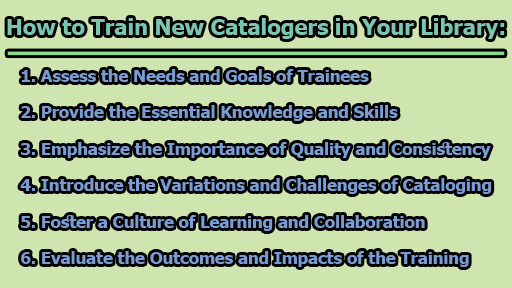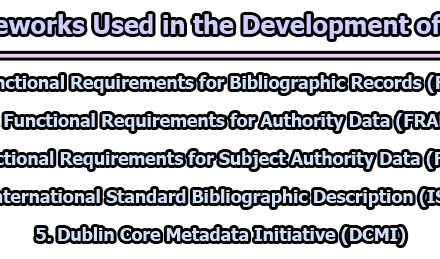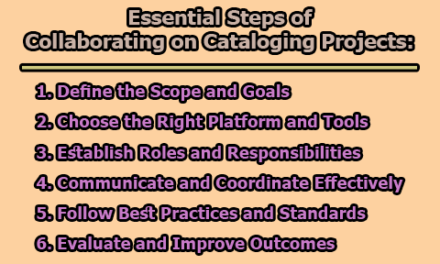How to Train New Catalogers in Your Library:
Cataloging is a critical skill for librarians, as it plays a pivotal role in organizing, describing, and providing access to library resources. New catalogers face the daunting task of learning the standards, rules, and tools of this profession. To train new catalogers effectively, a comprehensive and well-structured training program is essential. In this article, we will explore how to train new catalogers in your library.
1. Assess the Needs and Goals of Trainees: Before diving into cataloging training, it is crucial to assess the needs and goals of the trainees. Understanding their background, experience, and expectations is essential. Key questions to consider include:
- What kind of library do they work in?
- What types of resources do they catalog?
- What cataloging system is in use?
- What are their learning styles and preferences?
- How much time do they have for training?
By gathering this information, trainers can customize the training content, methods, and pace to cater to the specific needs and circumstances of the trainees.
2. Provide the Essential Knowledge and Skills: The core of cataloging training is to impart essential knowledge and skills to new catalogers. This includes teaching them the fundamental concepts and principles of cataloging, such as metadata, authority control, and bibliographic formats. In addition, they should be introduced to specific standards and rules governing cataloging, including RDA, AACR2, MARC, and LCSH. Practical skills, such as using cataloging tools and software (e.g., OCLC, Library of Congress, and local systems), should also be covered.
To ensure effective learning, a variety of teaching methods can be employed, such as lectures, demonstrations, exercises, quizzes, and feedback mechanisms.
3. Emphasize the Importance of Quality and Consistency: One of the primary goals of cataloging is to maintain the quality and consistency of the library catalog, which directly impacts the user experience and resource discovery. Throughout the training, it is crucial to emphasize the importance of quality and consistency and to guide new catalogers on applying standards and rules accurately. Common cataloging errors and problems should be highlighted, along with strategies for avoiding or correcting them. New catalogers should be encouraged to review their work, inspect their records, and consult authoritative sources and guidance.
4. Introduce the Variations and Challenges of Cataloging: Cataloging is a nuanced process that involves dealing with a wide array of resources, formats, languages, subjects, and user needs. Trainees should be exposed to the variations and challenges they may encounter and taught how to adapt to different scenarios. For example, they should learn how to catalog electronic resources, audiovisual materials, rare books, and foreign language materials. Handling complex or ambiguous cases, such as multiple authors, editions, or titles, should also be covered. Moreover, new catalogers should be prepared to adapt to changes and updates in cataloging standards and practices.
5. Foster a Culture of Learning and Collaboration: Cataloging is a continuous learning process that necessitates staying up-to-date with the latest developments in the field. To foster a culture of learning and collaboration among new catalogers, several strategies can be employed:
- Create a cataloging manual, a wiki, or a blog documenting library policies, procedures, and best practices.
- Organize regular meetings, workshops, webinars, or conferences to facilitate discussions about cataloging-related issues.
- Encourage new catalogers to join professional associations, networks, or communities that provide support, advice, and information on cataloging.
By implementing these measures, new catalogers can benefit from ongoing support and resources to enhance their skills and knowledge.
6. Evaluate the Outcomes and Impacts of the Training: The final step in cataloging training involves evaluating the outcomes and impacts of the training program. Various methods and tools, including surveys, interviews, tests, observations, and statistical analysis, can be used to measure the progress and performance of new catalogers. Feedback from the new catalogers themselves, their supervisors, colleagues, and library users can provide valuable insights.
Evaluating the training allows for the identification of strengths and weaknesses in the program, the achievements and challenges of the new catalogers, and areas for improvement and development. This feedback loop ensures that the training program continues to evolve and meet the changing needs of the library and its patrons.
In conclusion, training new catalogers in a library is a multifaceted process that requires careful planning and execution. By following these tips and best practices, libraries can develop effective cataloging training programs that empower new catalogers with the knowledge and skills they need to excel in their roles. Ultimately, a well-trained cataloging team contributes to a more organized and accessible library collection, enhancing the overall user experience.

Library Lecturer at Nurul Amin Degree College










